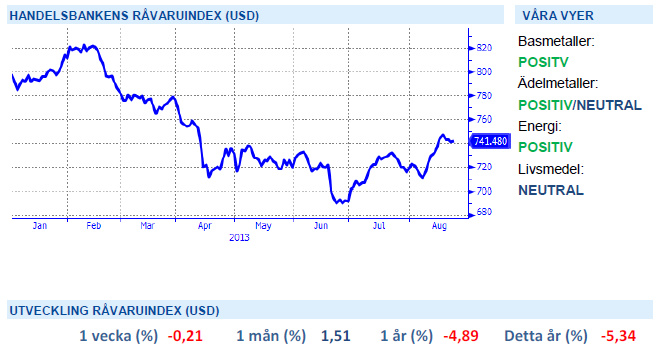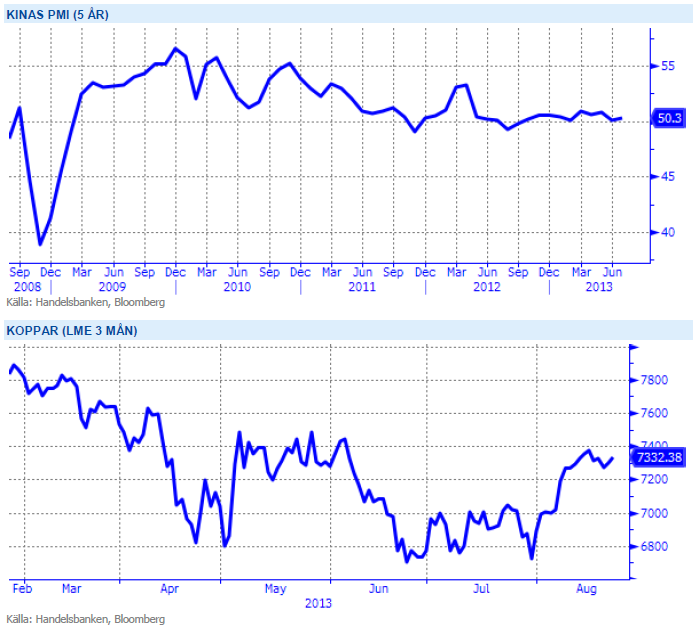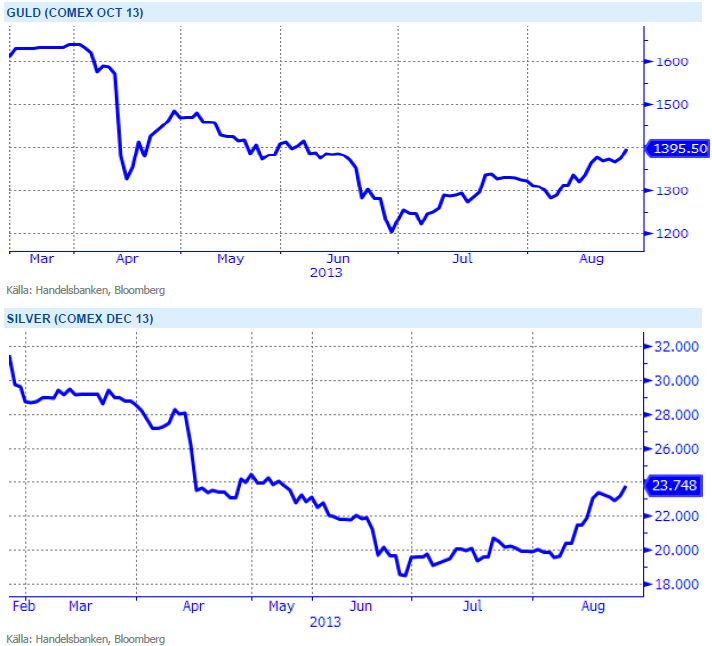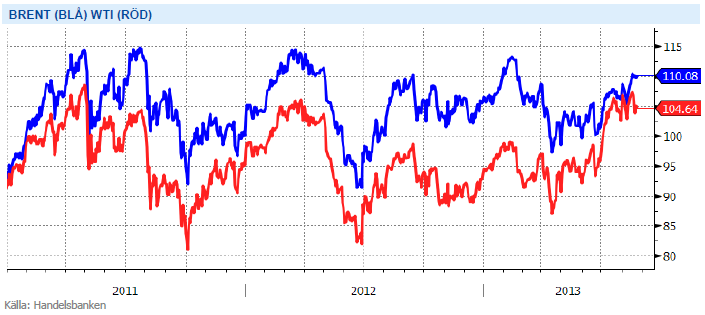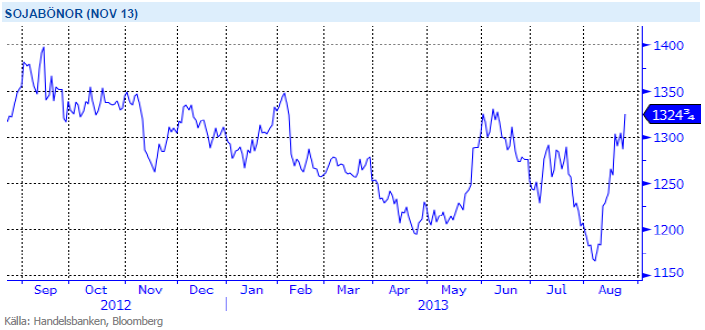Analys
SHB Råvarubrevet 23 augusti 2013

 Råvaror allmänt
Råvaror allmänt
Har katalysatorn kommit?
Ekonomisk data har förbättrats i de tre stora regionerna USA, Europa och Kina samtidigt som dollarn har försvagats och geopolitisk oro råder (i Egypten, Irak och Iran), det är en perfekt cocktail för stigande råvarupriser. (En cocktail ska som bekant bestå av tre ingredienser varav en skall vara starkare).
Vi har favoriserat kinaexponerade råvaror under hela året utan stor framgång. Vi har väntat på en katalysator som skulle driva på marknaden som stirrat sig blind på Kinas fallande BNP. Nu har juli månads data från Kina varit bra och följts upp av ett preliminärt starkare inköpschefsindex för augusti (50.1 mot juli 47.7). Kanske är detta de första tecknen på att Kinas ekonomi stabiliseras och kommer fortsätta starkare snarare än svagare under resten av året. I så fall har basmetallerna en given uppsida där nickel har potential att stiga med 10-15%.
Basmetaller
Kina i fokus
Veckans preliminära PMI (inköpschefsindex) från Kina överraskade marknaden och vände en fallande trend. Trots det stannar metallerna på minus denna vecka där nickel har haft det tuffast med – 4%, följt av aluminium på -3,5%. Vi ser dock ljust på framtiden där ett starkare Kina ger stöd åt basmetallerna. Det kommer klara signaler från kinesiska ledare där de kommer försvara den lägsta tillåtna tillväxten plus att de tycks oroade att inbromsningen gått för långt och för snabbt.
Troligt nu är att ledarna kommer att finjustera ekonomin så att den uppvisar stabilisering eller uppgång under Q3. Den sena uppgången i PMI förklarar vi med att det råder en stor pessimism i systemet kring Kina och det tar tid att mentalt svänga om till mer positiv anda. Denna effekt kan man utnyttja och handla basmetaller på.
Nickel är den basmetall som gått ner mest under året och med många gruvor som går med förlust på dagens prisnivåer tror vi på stigande priser. Vi tror på: LONG NICKEL H
Ädelmetaller
Guld, alltjämt konstruktiv prisutveckling!
Förra veckan knöt vi an till vårt köpcase för guld, som går emot vår mer basala långsiktiga vy, och som innebär att vi tror att 1450 dollar per uns är en rimlig nivå. Denna veckan har guldet spenderat i ett tight och händelselöst prisintervall mellan 1355 och 1375, men nu på eftermiddagen tog det ny fart uppåt. I skrivande stund ligger vi strax under 1400 dollar, och vi ser ingen anledning till att revidera vare sig vår kortsiktiga vy (minst 1450 dollar), eller vår mer lånsiktiga skepsis. Men för tillfället handlar vi i en bekväm upptrend, och varken Feds protokoll tidigare i veckan, eller inkommande makrodata har gjort något för att ändra denna trenden.
I ett läge där råvaror generellt har viktats ned av institutionella placerare kan guld och silver få en ”omotiverad” uppgång när dessa indexköpare återvänder till råvaror drivit av bättre utsikter för Kina och USA. Vi tror på: LONG GULD H och LONG SILVER H
Energi
Osäkerhet kring energibalansen
SHB Power stiger med 1.5% under veckan på osäkerhet kring energibalansen då låga nederbördsmängder riskerar att försämra energibalansen med 5-6 TWh till ett underskott om -11 TWh. Såväl kol som utsläppsrätter handlas oförändrat men potentialen bör finnas på uppsidan med nuvarande väderprognos. Under årets energidagar i Oslo verkade de flesta överens om att det låga priset på el kommer att bestå fram till 2020. Förnyelsebara investeringar i kombination med ny finsk kärnkraft skapar överskott vilket till viss del balanseras av kolpriskurvan men lägre risk för elprischocker. Skärpta utsläppskrav efter 2020 och utfasning av svenska kärnkraftsverk är en stor osäkerhet men de långa prognoserna har justerats ned till ca 34-35 öre per kWh.
Oljan handlas oförändrat under veckan men geopolitisk risk, starkare ledande indikatorer för OECD och låg reservkapacitet inom OPEC talar för ett fortsatt starkt oljepris. Orkansäsong i USA och säsongsmässigt högre efterfrågan på oljeprodukter i OECD gynnar också bilden för olja. Intressant att se hur snabbt gapet mellan Brent och WTI minskat under sommaren. Från att ha varit närmare 0 i mitten av juli handlas spreaden nu på strax över 5 dollar att jämföra med förra årets snitt om 19 dollar och hela 27.88 dollar som lägst i november 2011. Anledningen till varför vi haft en så stor prisskillnad under 2011 och 2012 är transportbegränsningar i USA som försvårat möjligheten att få ut WTI oljan. En ökad skifferproduktion i kombination med ett lägre kapacitetsutnyttjande hos raffinaderierna har då skapat ett lokalt överskott och pressat WTI marknaden till skillnad från Nordsjöoljan Brent som är en fraktad olja och bättre kan täppa till eventuella arbitragefönster. Detta innebär exempelvis att Brent reagerar mer vid politisk oro och produktionsstörningar. Flera amerikanska infrastrukturella projekt har kommit på plats under 2013 såsom pipelines och förbättrade järnvägslänkar vid terminalerna samtidigt som lokala raffinaderier ökat körningen till nivåer vi inte sett sedan 2007. En förbättrad infrastruktur har också givit lokala raffinaderier tillgång till inhemsk olja av Brent kvalité (dvs light) vilken då ersatt behovet av Brent.
Utsikterna framöver pekar på ett torrare scenario mot normalt vilket i kombination med något starkare kontinentala marknader bör ge fortsatt stöd. Vi tror på: LONG EL
Livsmedel
Volatil jordbruksmarknad
Terminspriserna på vete har gått ned något under veckan i både Chicago och Paris. Skörden av höstvete i USA är nu i princip helt klar och vårveteskörden går raskt framåt med bara några få småskurar i vissa områden. Avkastningen på vårvetet uppges vara något över förväntan. Statistics Canada uppskattar landets totala veteskörd till den största veteskörden i Kanada sedan 1991. Australien har bra väderförhållanden för vetet i de södra och sydvästra delarna av landet. Även i Argentina önskas mer regn på redan sådd gröda. I Ukraina är veteskörden i stort sett klar. Den ryska skörden går framåt och både kvalitet och avkastning uppges ha förbättrats under den senaste tiden. Även i EU går skörden framåt i bra fart, i Storbritannien uppges dock (som vanligt) småskurar fördröja skörden. Både avkastning och kvalitet uppges vara hög. Vetepriserna kommer fortsätta att påverkas främst av utvecklingen för majsen i USA.
Priserna på majs i Chicago har handlats upp under den gångna veckan. Torrt väder i en del regioner skapar viss oro över de amerikanska grödorna och priserna går upp och ned utifrån varierande väderprognoser. Än verkar de flesta överens om att det blir en riktigt stor majsskörd i år, frågan är bara hur stor? Den närmsta tiden kommer nog bli fortsatt ganska volatil men vi tror det blir svårt att hålla majsen kvar på nuvarande nivåer när skörden kommer igång på allvar – flera s.k. ”crop tours” pekar även på en i många regioner klart högre avkastning än vad USDA spår.
Priserna på sojabönor i Chicago noteras upp sedan förra veckan, precis som för majsen påverkat av torrt väder i en del områden i USA. En del regn har stabiliserat situationen i vissa områden men på andra håll önskas klart mycket mer. Man ska dock ej glömma att torrt väder samtidigt minskar tidigare oro för eventuell frost senare i september – vid torrt väder mognar den annars ovanligt sent utvecklade grödan klart snabbare. Nästa vecka ser ut att bli ganska torr och varm, varför vi nog kan vänta oss fortsatt oro ett tag till. Om/när regn kommer lär dock nedsidan vara ganska stor för sojabönorna, inte minst efter den senaste tidens snabba och ganska stora uppgång.
Vi håller en fortsatt neutral vy för vårt livmedelsindex.
Handelsbankens Råvaruindex
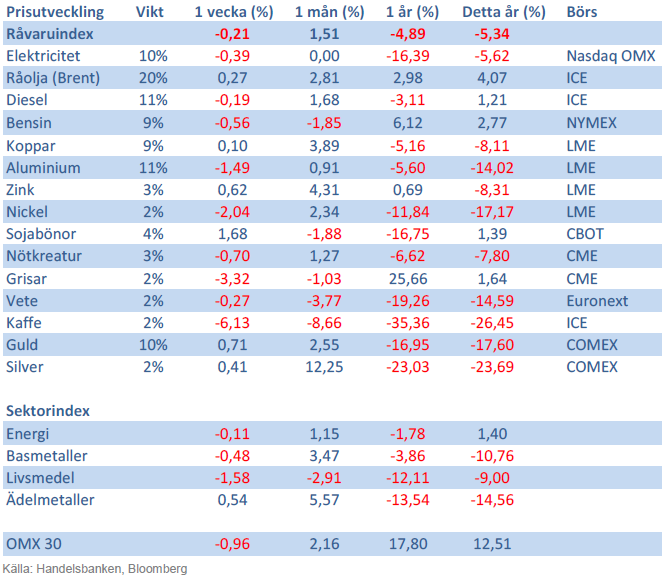
Handelsbankens råvaruindex består av de underliggande indexen för respektive råvara. Vikterna är bestämda till hälften från värdet av nordisk produktion (globala produktionen för sektorindex) och till hälften från likviditeten i terminskontrakten.
[box]SHB Råvarubrevet är producerat av Handelsbanken och publiceras i samarbete och med tillstånd på Råvarumarknaden.se[/box]
Ansvarsbegränsning
Detta material är producerat av Svenska Handelsbanken AB (publ) i fortsättningen kallad Handelsbanken. De som arbetar med innehållet är inte analytiker och materialet är inte oberoende investeringsanalys. Innehållet är uteslutande avsett för kunder i Sverige. Syftet är att ge en allmän information till Handelsbankens kunder och utgör inte ett personligt investeringsråd eller en personlig rekommendation. Informationen ska inte ensamt utgöra underlag för investeringsbeslut. Kunder bör inhämta råd från sina rådgivare och basera sina investeringsbeslut utifrån egen erfarenhet.
Informationen i materialet kan ändras och också avvika från de åsikter som uttrycks i oberoende investeringsanalyser från Handelsbanken. Informationen grundar sig på allmänt tillgänglig information och är hämtad från källor som bedöms som tillförlitliga, men riktigheten kan inte garanteras och informationen kan vara ofullständig eller nedkortad. Ingen del av förslaget får reproduceras eller distribueras till någon annan person utan att Handelsbanken dessförinnan lämnat sitt skriftliga medgivande. Handelsbanken ansvarar inte för att materialet används på ett sätt som strider mot förbudet mot vidarebefordran eller offentliggörs i strid med bankens regler.
Analys
Tightening fundamentals – bullish inventories from DOE

The latest weekly report from the US DOE showed a substantial drawdown across key petroleum categories, adding more upside potential to the fundamental picture.

Commercial crude inventories (excl. SPR) fell by 5.8 million barrels, bringing total inventories down to 415.1 million barrels. Now sitting 11% below the five-year seasonal norm and placed in the lowest 2015-2022 range (see picture below).
Product inventories also tightened further last week. Gasoline inventories declined by 2.1 million barrels, with reductions seen in both finished gasoline and blending components. Current gasoline levels are about 3% below the five-year average for this time of year.
Among products, the most notable move came in diesel, where inventories dropped by almost 4.1 million barrels, deepening the deficit to around 20% below seasonal norms – continuing to underscore the persistent supply tightness in diesel markets.
The only area of inventory growth was in propane/propylene, which posted a significant 5.1-million-barrel build and now stands 9% above the five-year average.
Total commercial petroleum inventories (crude plus refined products) declined by 4.2 million barrels on the week, reinforcing the overall tightening of US crude and products.


Analys
Bombs to ”ceasefire” in hours – Brent below $70

A classic case of “buy the rumor, sell the news” played out in oil markets, as Brent crude has dropped sharply – down nearly USD 10 per barrel since yesterday evening – following Iran’s retaliatory strike on a U.S. air base in Qatar. The immediate reaction was: “That was it?” The strike followed a carefully calibrated, non-escalatory playbook, avoiding direct threats to energy infrastructure or disruption of shipping through the Strait of Hormuz – thus calming worst-case fears.

After Monday morning’s sharp spike to USD 81.4 per barrel, triggered by the U.S. bombing of Iranian nuclear facilities, oil prices drifted sideways in anticipation of a potential Iranian response. That response came with advance warning and caused limited physical damage. Early this morning, both the U.S. President and Iranian state media announced a ceasefire, effectively placing a lid on the immediate conflict risk – at least for now.
As a result, Brent crude has now fallen by a total of USD 12 from Monday’s peak, currently trading around USD 69 per barrel.
Looking beyond geopolitics, the market will now shift its focus to the upcoming OPEC+ meeting in early July. Saudi Arabia’s decision to increase output earlier this year – despite falling prices – has drawn renewed attention considering recent developments. Some suggest this was a response to U.S. pressure to offset potential Iranian supply losses.
However, consensus is that the move was driven more by internal OPEC+ dynamics. After years of curbing production to support prices, Riyadh had grown frustrated with quota-busting by several members (notably Kazakhstan). With Saudi Arabia cutting up to 2 million barrels per day – roughly 2% of global supply – returns were diminishing, and the risk of losing market share was rising. The production increase is widely seen as an effort to reassert leadership and restore discipline within the group.
That said, the FT recently stated that, the Saudis remain wary of past missteps. In 2018, Riyadh ramped up output at Trump’s request ahead of Iran sanctions, only to see prices collapse when the U.S. granted broad waivers – triggering oversupply. Officials have reportedly made it clear they don’t intend to repeat that mistake.
The recent visit by President Trump to Saudi Arabia, which included agreements on AI, defense, and nuclear cooperation, suggests a broader strategic alignment. This has fueled speculation about a quiet “pump-for-politics” deal behind recent production moves.
Looking ahead, oil prices have now retraced the entire rally sparked by the June 13 Israel–Iran escalation. This retreat provides more political and policy space for both the U.S. and Saudi Arabia. Specifically, it makes it easier for Riyadh to scale back its three recent production hikes of 411,000 barrels each, potentially returning to more moderate increases of 137,000 barrels for August and September.
In short: with no major loss of Iranian supply to the market, OPEC+ – led by Saudi Arabia – no longer needs to compensate for a disruption that hasn’t materialized, especially not to please the U.S. at the cost of its own market strategy. As the Saudis themselves have signaled, they are unlikely to repeat previous mistakes.
Conclusion: With Brent now in the high USD 60s, buying oil looks fundamentally justified. The geopolitical premium has deflated, but tensions between Israel and Iran remain unresolved – and the risk of missteps and renewed escalation still lingers. In fact, even this morning, reports have emerged of renewed missile fire despite the declared “truce.” The path forward may be calmer – but it is far from stable.
Analys
A muted price reaction. Market looks relaxed, but it is still on edge waiting for what Iran will do

Brent crossed the 80-line this morning but quickly fell back assigning limited probability for Iran choosing to close the Strait of Hormuz. Brent traded in a range of USD 70.56 – 79.04/b last week as the market fluctuated between ”Iran wants a deal” and ”US is about to attack Iran”. At the end of the week though, Donald Trump managed to convince markets (and probably also Iran) that he would make a decision within two weeks. I.e. no imminent attack. Previously when when he has talked about ”making a decision within two weeks” he has often ended up doing nothing in the end. The oil market relaxed as a result and the week ended at USD 77.01/b which is just USD 6/b above the year to date average of USD 71/b.

Brent jumped to USD 81.4/b this morning, the highest since mid-January, but then quickly fell back to a current price of USD 78.2/b which is only up 1.5% versus the close on Friday. As such the market is pricing a fairly low probability that Iran will actually close the Strait of Hormuz. Probably because it will hurt Iranian oil exports as well as the global oil market.
It was however all smoke and mirrors. Deception. The US attacked Iran on Saturday. The attack involved 125 warplanes, submarines and surface warships and 14 bunker buster bombs were dropped on Iranian nuclear sites including Fordow, Natanz and Isfahan. In response the Iranian Parliament voted in support of closing the Strait of Hormuz where some 17 mb of crude and products is transported to the global market every day plus significant volumes of LNG. This is however merely an advise to the Supreme leader Ayatollah Ali Khamenei and the Supreme National Security Council which sits with the final and actual decision.
No supply of oil is lost yet. It is about the risk of Iran closing the Strait of Hormuz or not. So far not a single drop of oil supply has been lost to the global market. The price at the moment is all about the assessed risk of loss of supply. Will Iran choose to choke of the Strait of Hormuz or not? That is the big question. It would be painful for US consumers, for Donald Trump’s voter base, for the global economy but also for Iran and its population which relies on oil exports and income from selling oil out of that Strait as well. As such it is not a no-brainer choice for Iran to close the Strait for oil exports. And looking at the il price this morning it is clear that the oil market doesn’t assign a very high probability of it happening. It is however probably well within the capability of Iran to close the Strait off with rockets, mines, air-drones and possibly sea-drones. Just look at how Ukraine has been able to control and damage the Russian Black Sea fleet.
What to do about the highly enriched uranium which has gone missing? While the US and Israel can celebrate their destruction of Iranian nuclear facilities they are also scratching their heads over what to do with the lost Iranian nuclear material. Iran had 408 kg of highly enriched uranium (IAEA). Almost weapons grade. Enough for some 10 nuclear warheads. It seems to have been transported out of Fordow before the attack this weekend.
The market is still on edge. USD 80-something/b seems sensible while we wait. The oil market reaction to this weekend’s events is very muted so far. The market is still on edge awaiting what Iran will do. Because Iran will do something. But what and when? An oil price of 80-something seems like a sensible level until something do happen.
-

 Nyheter3 veckor sedan
Nyheter3 veckor sedanStor uppsida i Lappland Guldprospekterings aktie enligt analys
-

 Nyheter4 veckor sedan
Nyheter4 veckor sedanBrookfield ska bygga ett AI-datacenter på hela 750 MW i Strängnäs
-

 Nyheter3 veckor sedan
Nyheter3 veckor sedanSilverpriset släpar efter guldets utveckling, har mer uppsida
-

 Nyheter4 veckor sedan
Nyheter4 veckor sedanTradingfirman XTX Markets bygger datacenter i finska Kajana för 1 miljard euro
-

 Nyheter2 veckor sedan
Nyheter2 veckor sedanUppgången i oljepriset planade ut under helgen
-

 Nyheter2 veckor sedan
Nyheter2 veckor sedanLåga elpriser i sommar – men mellersta Sverige får en ökning
-

 Analys2 veckor sedan
Analys2 veckor sedanVery relaxed at USD 75/b. Risk barometer will likely fluctuate to higher levels with Brent into the 80ies or higher coming 2-3 weeks
-

 Nyheter1 vecka sedan
Nyheter1 vecka sedanMahvie Minerals växlar spår – satsar fullt ut på guld


